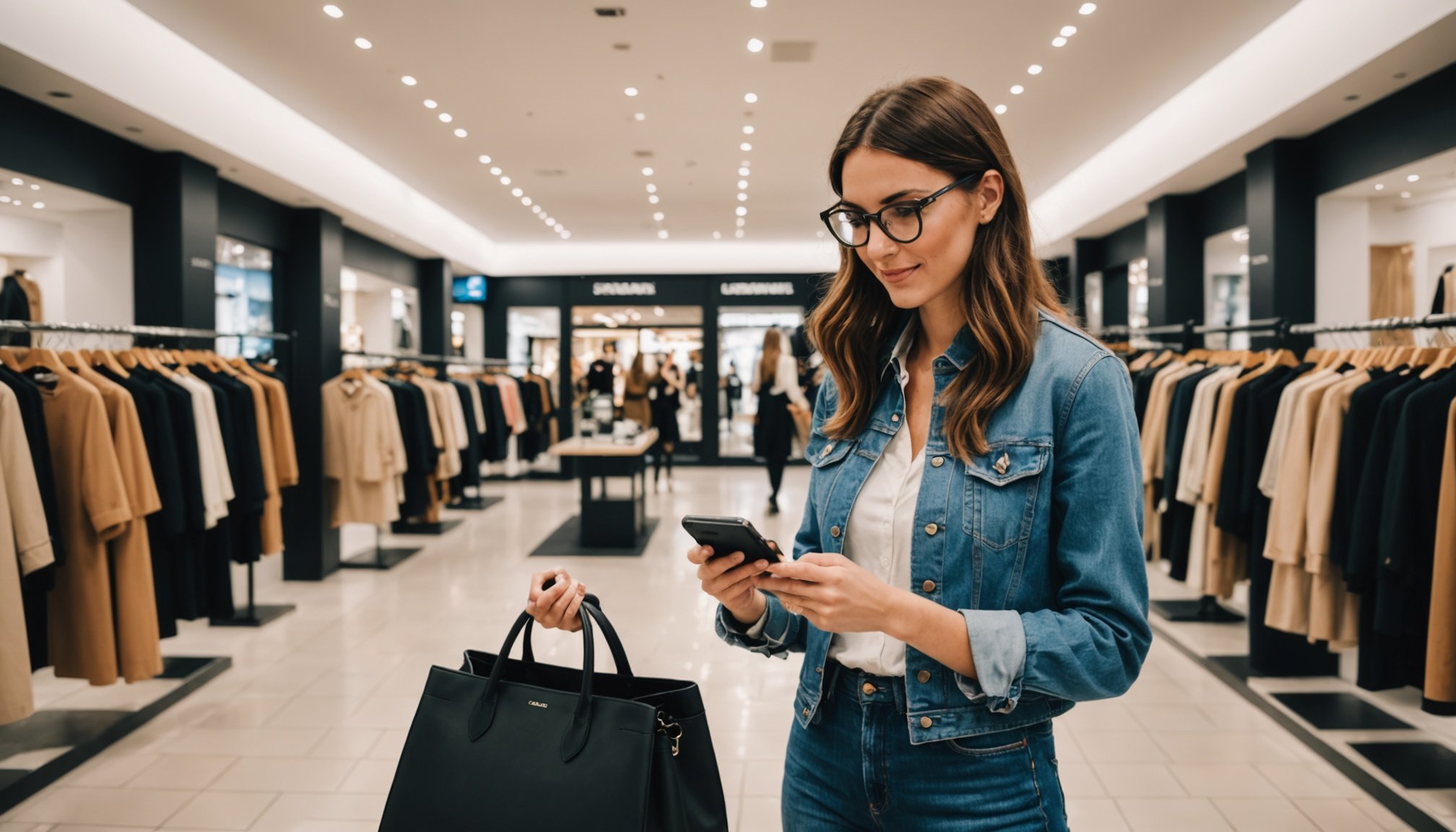Impact of Augmented Reality on UK Fashion Retail
Augmented Reality (AR) is making significant waves in the UK fashion industry, transitioning shopping experiences into a more virtual, interactive domain. AR technologies in retail are designed to enhance the shopping journey, giving consumers the ability to interact with products virtually before making a purchase. This new form of virtual shopping experience is transforming how customers can visualise clothing and accessories, often without setting foot in a physical store.
The influence of AR on consumer behaviour is notable. With virtual try-ons and interactive product displays, customers feel more confident in their buying decisions. The convenience and novelty of AR in fashion retail are driving shifts towards more digitally-oriented shopping behaviours.
In the same genre : Supercharge Your UK Logistics: The Definitive Guide to Leveraging Data Analytics for Enhanced Supply Chain Efficiency
Statistical findings indicate a growing adoption of AR within the UK fashion retail sector, with numerous brands embracing this technology to improve customer satisfaction. The seamless integration of AR into the shopping journey not only increases engagement but also supports personalised experiences, which are crucial in today’s competitive market. As AR continues to evolve, its impact on the UK fashion industry suggests an exciting trajectory for both businesses and consumers alike.
Applications of Augmented Reality in Fashion Retail
The ways in which augmented reality (AR) enhances retail are constantly expanding, offering new virtual shopping experiences that redefine the UK fashion industry.
Topic to read : Transforming UK Online Retail: Harnessing Machine Learning for Instant Fraud Detection
Virtual Try-On Experiences
Virtual try-ons are revolutionising the way consumers engage with products. By utilising AR applications, shoppers can now visualise how clothing and accessories fit without physically trying them on. This not only saves time but also enhances convenience, allowing shoppers to experiment with various styles effortlessly. Technologies such as 3D body scanning and digital overlays have become pivotal in providing accurate visual representations, fostering increased consumer confidence in online purchases.
AR Showrooms
Brands are innovating with AR showrooms to create immersive shopping environments. These digital spaces allow for interaction with products in a lifelike manner. Shoppers can explore collections and outfits in a simulated reality, often from the comfort of their homes. This experience enriches traditional retail by offering depth and interactivity, driving brand engagement and consumer interest in new collections.
Interactive Product Displays
Interactive displays use AR to transform static product views into dynamic presentations. By incorporating interactive shopping elements, these displays offer detailed information and options for customisation. Retailers leverage this technology to captivate customers and encourage exploration, ultimately enhancing their shopping journey and decision-making processes.
Case Studies of Brands Utilizing AR
In the ever-evolving UK fashion industry, several brands have significantly embraced AR innovation in fashion, revolutionising how they engage with consumers. These brand case studies demonstrate the profound impact AR can have when integrated thoughtfully into retail strategies.
Analysis of Leading Brands Implementing AR
Brands like Burberry and ASOS have set benchmarks in the use of AR, showcasing successful AR campaigns that resonate with tech-savvy consumers. Burberry implemented an AR campaign allowing customers to experience its flagship store virtually, thus immersing them into an interactive digital environment.
Specific Campaigns Demonstrating Effective AR Use
ASOS has effectively utilised AR applications to create virtual catwalks, where customers can explore how garments look in motion. This not only enhances the shopping experience but also provides real-time visualisation, boosting consumer confidence in online purchases.
Consumer Feedback on AR Experiences Offered by Brands
Consumer reactions to these innovations remain overwhelmingly positive, with many appreciating the ability to make informed purchasing decisions through virtual shopping experiences. Feedback indicates an increase in customer satisfaction due to the engaging and personalised nature of AR applications, underscoring their importance in modern retail. By successfully harnessing AR technology, these brands not only captivate consumers but also set a precedent for future retail practices.
Benefits of Augmented Reality in Fashion Retail
Augmented reality (AR) in fashion retail provides numerous benefits, especially in enhancing customer engagement. It allows brands to create immersive and interactive shopping experiences that captivate consumers. AR applications enable customers to interact with products in a way that feels personal and engaging, increasing their connection to the brand.
Personalization in retail is another significant advantage of AR. By analysing consumer preferences and behaviours, AR can tailor experiences to individual shoppers. This customization boosts the likelihood of meeting specific consumer needs, resulting in a more rewarding shopping experience. Through personalised recommendations and experiences, AR helps build stronger relationships between brands and their customers.
AR also leads to improved purchasing decisions, as it offers detailed visualizations that aid in evaluating products. Consumers feel more confident about their choices when they can virtually try on items or explore interactive displays that provide comprehensive product information. This boosts customer satisfaction and can lead to increased loyalty and repeat business.
In conclusion, AR technology not only enriches the shopping experience but also fosters trust and satisfaction, transforming how consumers interact with their favourite brands in the ever-evolving UK fashion industry.
Future Trends of AR in UK Fashion Retail
The future of Augmented Reality (AR) in the UK fashion industry promises exciting developments, as this technology continues to reshape the landscape of virtual shopping experiences. As AR progresses, several key trends are emerging that point towards a more immersive and personalised future for retail.
Predictions for the future landscape of AR in fashion are focused on the continued integration of AI. Artificial Intelligence is set to enhance AR by providing more refined personalisation and realistic interactions, further improving customer engagement. This combination will allow retailers to offer customised experiences based on individual preferences and purchase history.
Moreover, evolving technologies and hardware advancements are expected to lead to more seamless and efficient AR applications. Enhanced AR glasses and improved mobile devices are among the tools that will facilitate smoother AR experiences, making them more accessible and realistic.
Emerging trends to watch include the use of mixed reality (MR), where physical and digital worlds blend seamlessly, and advanced biometric scanning for precise virtual try-ons. These innovations are likely to drive the next wave of creativity and functionality, reinforcing AR’s transformative role in retail. Brands will need to stay informed and adaptable to leverage these trends successfully.
Technological Advancements Supporting AR in Retail
The AR technology trends are rapidly advancing, spurring new opportunities in the innovations in fashion retail. Significant strides in hardware developments are pivotal. AR glasses and mobile devices continue to evolve, offering more seamless and interactive AR experiences. These advancements enhance realism and accessibility, allowing consumers to engage with products effortlessly anywhere.
Hardware Developments
The future of AR in retail is tightly linked to improved hardware. Recent innovations include lighter, more comfortable AR glasses with enhanced visual capabilities. These devices facilitate more realistic interactions between consumers and virtual fashions. Additionally, advancements in mobile technology enhance AR accessibility, making sophisticated AR interactions possible from the convenience of a smartphone.
Software Solutions for AR
Software also plays a vital role in expanding AR’s capabilities. Innovations in AR software now allow for more detailed and accurate digital overlays. These enhancements enable retailers to present life-like models of clothing and accessories, thus improving consumer confidence by presenting products with an unprecedented level of detail.
Integration with E-commerce Platforms
E-commerce platforms are increasingly integrating AR technologies, bridging the gap between online and in-store shopping. These integrations permit shoppers to interact with fashion items in a digital space that mirrors an in-store environment, enhancing virtual shopping experiences and supporting informed purchasing decisions.











